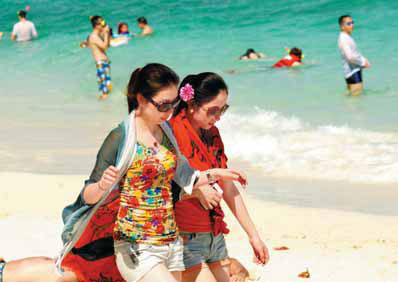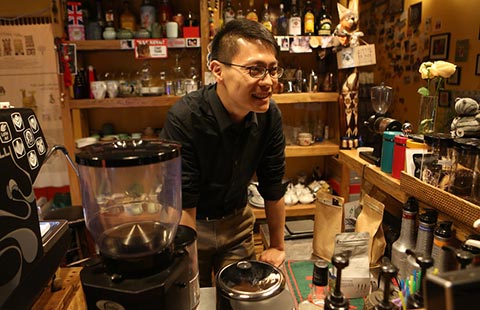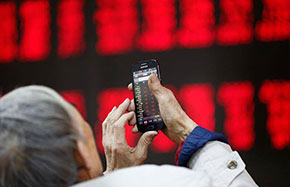Chinese spend less on hotels, still flash the cash
Despite the massive purchasing power Chinese tourists have shown overseas, a recent survey found travelers from China paid less than those from elsewhere for their hotel rooms in more than half of the countries contacted.
The report, conducted by hotels.com, a leading online accommodation booking website with almost 200,000 properties around the world, found most of the discounts in Europe, triggered by the troubled situation in the eurozone, according to Jessica Chuang, its senior marketing manager for Greater China.
 |
|
Two Chinese women walking on the beach in Phuket, Thailand. Many Chinese travelers chose to stay closer to home, choosing Asian destinations. Provided to China Daily |
Chinese travelers came fifth among the biggest spenders abroad with an average outlay of 1,069 yuan ($172) a night, according to the report based on bookings made on the website and prices paid by each customer per room per night in 71 cities.
The Japanese again spent the most away from home at 1,177 yuan followed by the Australians on 1,098 yuan and US citizens on 1,079 yuan.
In Europe
The Swiss were the highest-paying Europeans at 1,075 yuan followed by Norwegians at 1,055, Russians at 1,014 yuan and the British at 998 yuan.
The report found that the Chinese spent 414 yuan a night more on average when traveling abroad.
According to Global Blue, the largest tax-refund and shopping services provider, Chinese shoppers' tax refunds reached a historical high of 24.4 billion yuan in 2012, a strong surge of 58 percent from the 2011 figure. The average trade through tax refunds in Europe and Asia is about 7,122 yuan per person. Expenditure on luxury items contributed to between 60 and 70 percent of overseas purchasing.
Global Blue's survey overestimated the buying power of Chinese tourists overseas, with only 5 percent of them visiting Europe and the rest traveling to neighboring countries and regions where they spend much less than in European countries, said Jiang Yiyi, a researcher with the International Tourism Development Institute at China Tourism Academy.
Per capita spending
Jiang estimated that on average a Chinese traveler spent about $1,000 on every overseas trip including shopping, hotels and flights. "Most Chinese outbound travelers do not stay at luxury hotels and they prefer economy and medium-priced hotels," she said. "What they save from accommodation is used to buy luxury brands. Therefore it appears that Chinese travelers tend to spend more but actually that is not the whole picture."
Over the past 10 years Chinese outbound travel has increased 20 percent on average year-on-year, with destinations climbing from 18 to 146.
According to the 2013 travel budget report released by Ctrip.com, the country's leading online booking website, about 57 percent of travelers intend to increase their spending on tourism over what they spent in 2012. Ctrip's growth in outbound business exceeded 20 percent of its average operations, according to Niu Yue, spokesman for the company.
Hong Kong maintained its position as the most popular destination outside the Chinese mainland for Chinese travelers, according to the report. Mainland travelers to Hong Kong increased 20 percent and to Singapore 15 percent year-on-year, Jiang said.
The report found that San Diego made its first appearance on the list, ousting Osaka.
Many Chinese travelers chose to stay closer to home, choosing Asian destinations. Singapore, though, slid four places to No 6 and Kuala Lumpur dropped three to No 15. Bangkok rose to No 5 and Phuket to No 7, while Bali and Chiang Mai both rose one place to 18 and 19 respectively.
Of the 14 Asian destinations, China saw the average price paid rise by 2 percent to 626 yuan. Singapore was the Asian destination where the Chinese travelers paid the highest average price during 2012 at 1,383 yuan, a 1 percent rise.
Chinese travelers are willing to pay more in Hong Kong and the Philippines, both with an 11 percent increase taking them to 1,174 yuan and 702 yuan respectively. Macao saw a 3 percent rise to 1,173 yuan.
The largest fallers were Indonesia, down 10 percent to 1,285 yuan, and Cambodia, down 9 percent to 491 yuan, making it the destination where Chinese travelers paid the least overall on average in 2012.
In the Asia-Pacific region, Johan Svanstrom, vice-president of hotels.com APAC, said the Asian continent saw a price rise of two percent compared with 2011.
Among notable events moving prices upward, Svanstrom pointed out that China overtook the United Kingdom to become the second largest inbound source market, with prices rising after the 2011 tsunami and nuclear disaster in Japan and flooding in Thailand.
Big business and tourism destinations such as Singapore and Hong Kong saw continued high demand but rate rises were more moderate because of 25 new hotel openings in Hong Kong and further room openings in the Singapore mega-hotel industry.
The continuing rise in the number and spending of Chinese outbound travelers, as well as the rapid build up of the low cost and alternative carrier market in North East Asia, will drive the hotel industry development and investment for years to come, said Svanstrom.

















